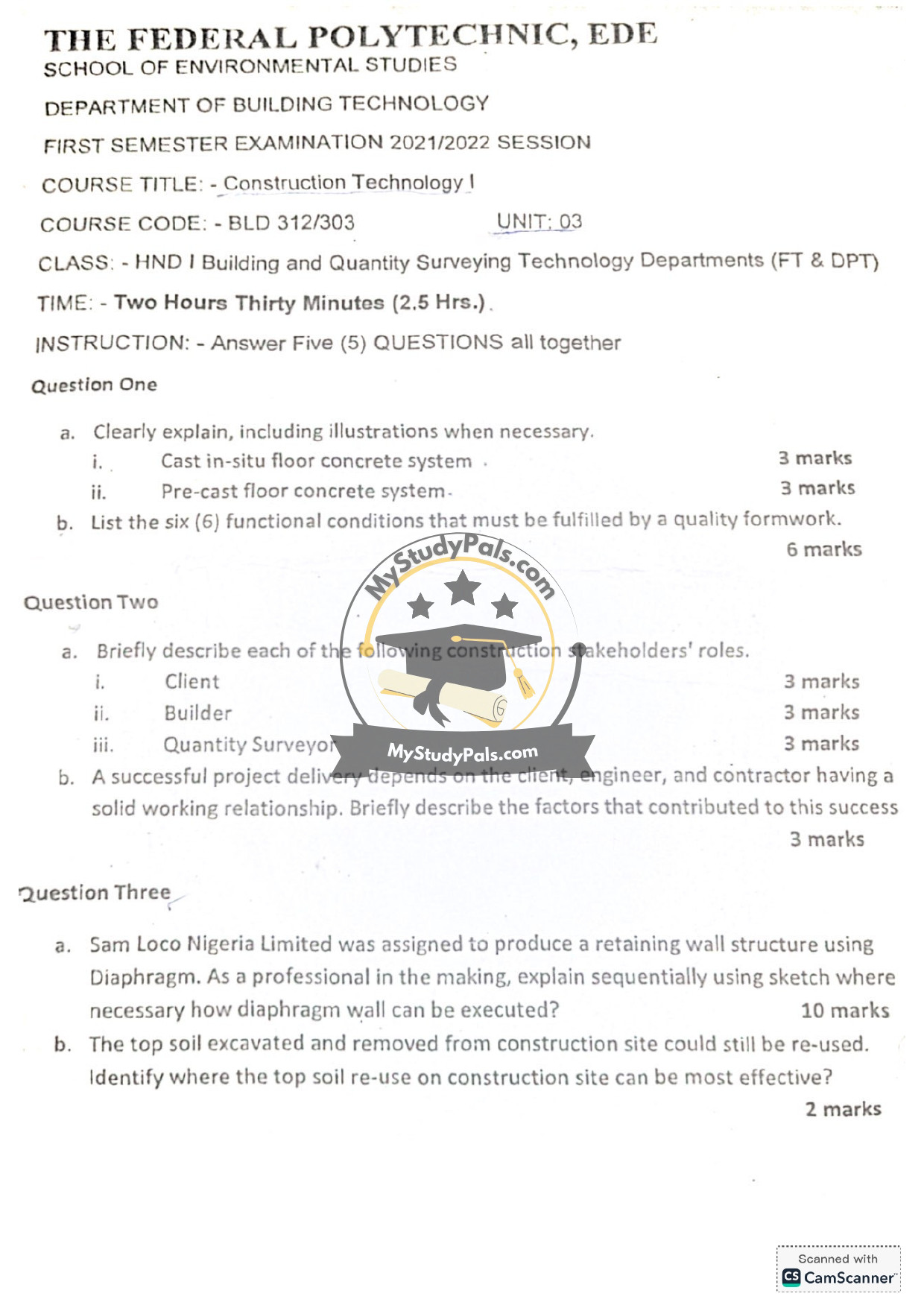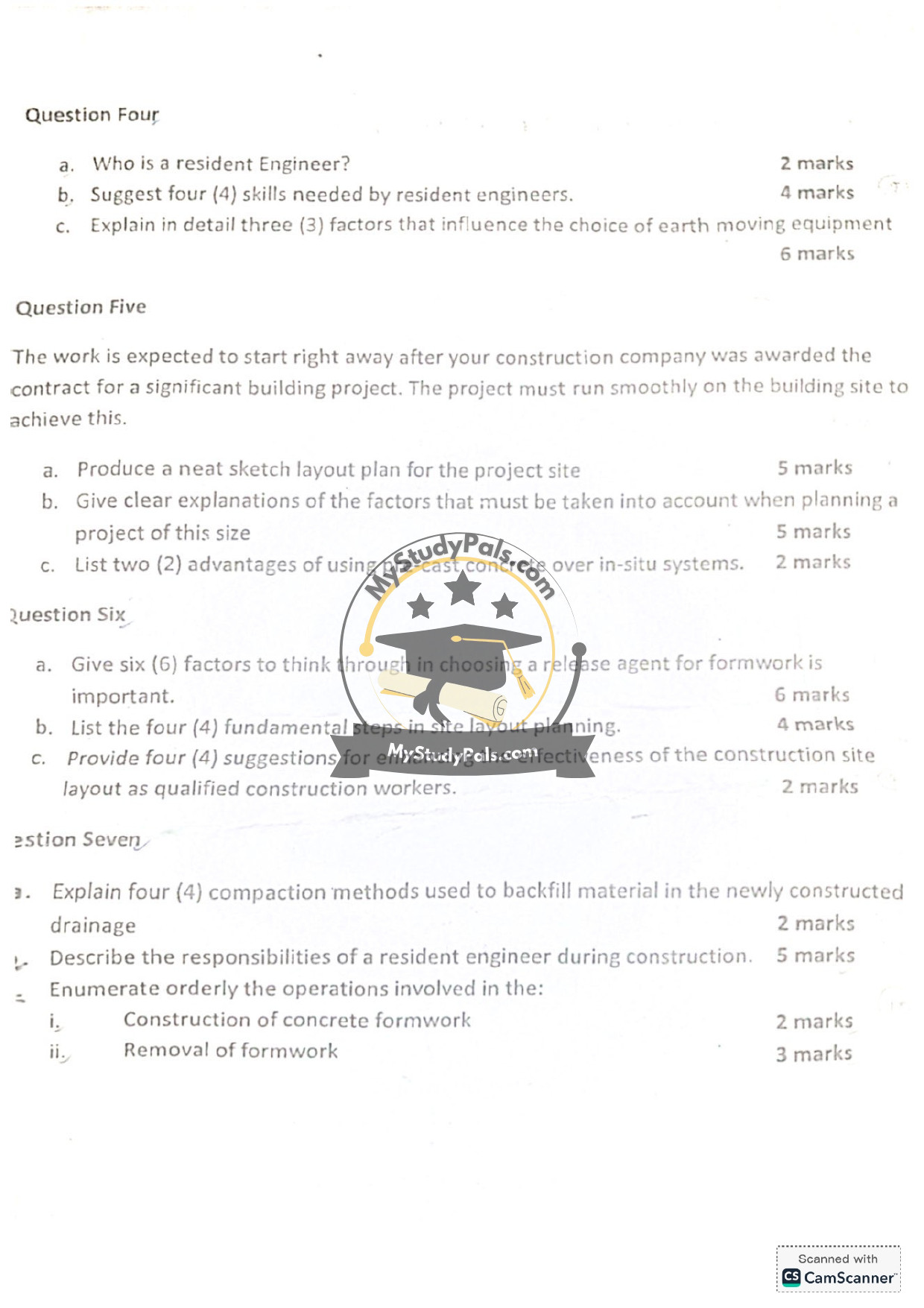ANWSER
—
### Question One
a. Clearly explain, including illustrations when necessary.
i. Cast in-situ floor concrete system:
Cast in-situ refers to concrete that is poured and cured directly at the construction site. This system involves setting up formwork, placing reinforcement, and pouring concrete on-site. It allows for flexibility in design and is suitable for complex shapes or custom structures. However, it requires more time for curing and is weather-dependent.
ii. Pre-cast floor concrete system:
Pre-cast concrete involves manufacturing concrete components off-site in a controlled environment. These components are then transported to the construction site and assembled. Advantages include faster construction, higher quality control, and reduced on-site labor. However, it requires precise planning and transportation logistics.
b. List the six (6) functional conditions that must be fulfilled by a quality formwork.
1. Adequate strength to support loads during construction.
2. Rigidity to maintain shape under pressure.
3. Tightness to prevent leakage of cement paste.
4. Smooth surface finish for aesthetic appeal.
5. Ease of assembly and dismantling.
6. Reusability for cost-effectiveness.
—
### Question Two
a. Briefly describe each of the following construction stakeholders’ roles.
i. Client:
The client is the project owner who initiates the project, provides funding, and defines requirements. They approve designs and ensure the project meets their needs.
ii. Builder:
The builder (contractor) is responsible for executing the construction work according to the design and specifications. They manage labor, materials, and timelines.
iii. Quantity Surveyor:
The quantity surveyor manages costs, prepares estimates, and ensures the project stays within budget. They also handle contracts and procurement.
b. Briefly describe the factors that contributed to a solid working relationship among client, engineer, and contractor.
1. Clear communication to avoid misunderstandings.
2. Defined roles and responsibilities for each party.
3. Mutual respect and collaboration to resolve issues.
—
### Question Three
a. Sequential execution of a diaphragm wall with sketches (if necessary):
1. Site Preparation: Clear and level the construction area.
2. Trench Excavation: Dig a trench using specialized equipment like a clamshell grab.
3. Slurry Support: Fill the trench with bentonite slurry to prevent collapse.
4. Reinforcement Placement: Insert steel cages into the trench.
5. Concrete Pouring: Pour concrete using tremie pipes to displace the slurry.
6. Curing: Allow the concrete to cure and gain strength.
7. Panel Joining: Repeat the process for adjacent panels to form a continuous wall.
b. Where excavated topsoil can be reused:
Topsoil can be reused for landscaping, backfilling, or as a base for green areas on the construction site.
—
### Question Four
a. Who is a resident Engineer?
A resident engineer is a professional who oversees construction activities on-site, ensuring compliance with designs, specifications, and safety standards.
b. Four skills needed by resident engineers:
1. Strong technical knowledge of construction methods.
2. Problem-solving abilities.
3. Effective communication skills.
4. Project management expertise.
c. Three factors influencing the choice of earth-moving equipment:
1. Soil Type: Hard soils may require heavy-duty equipment like bulldozers.
2. Project Size: Large projects may need high-capacity machines for efficiency.
3. Site Conditions: Limited space may favor compact equipment like backhoes.
—
### Question Five
a. Sketch layout plan for the project site:
*(Note: A sketch would include key areas like material storage, offices, access roads, and work zones, labeled clearly.)*
b. Factors to consider in planning a large project:
1. Site accessibility and logistics.
2. Safety and security measures.
3. Environmental impact.
4. Coordination of labor and materials.
c. Two advantages of pre-cast concrete over in-situ systems:
1. Faster construction time.
2. Higher quality control in manufacturing.
—
### Question Six
a. Six factors in choosing a release agent for formwork:
1. Compatibility with formwork material.
2. Ease of application.
3. Non-staining properties.
4. Cost-effectiveness.
5. Environmental impact.
6. Performance under weather conditions.
b. Four fundamental steps in site layout planning:
1. Analyze project requirements.
2. Allocate space for key areas.
3. Plan logistics and access routes.
4. Ensure safety and efficiency.
c. Four suggestions for enhancing construction site layout effectiveness:
1. Optimize material storage locations.
2. Minimize movement of equipment.
3. Implement clear signage.
4. Regularly review and adjust the layout.
—
### Section Seven
a. Four compaction methods for backfill material:
1. Vibratory Rollers: For granular soils.
2. Plate Compactors: For confined areas.
3. Sheepfoot Rollers: For cohesive soils.
4. Dynamic Compaction: For deep fills.
b. Responsibilities of a resident engineer:
1. Supervise construction activities.
2. Ensure adherence to designs.
3. Monitor quality and safety.
4. Resolve on-site issues.
5. Report progress to stakeholders.
c. Operations in formwork:
i. Construction of concrete formwork:
1. Design and measure formwork.
2. Assemble and secure panels.
ii. Removal of formwork:
1. Ensure concrete has cured sufficiently.
2. Carefully dismantle panels.
3. Inspect for damage or reuse potential.
—



